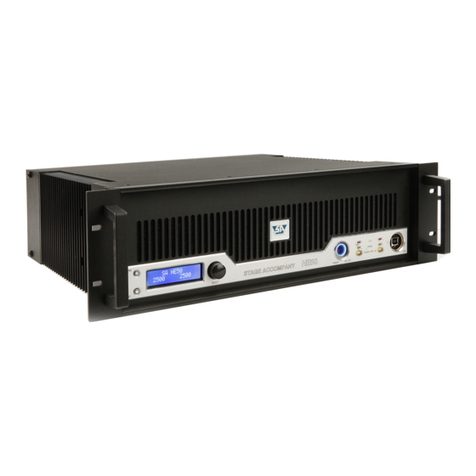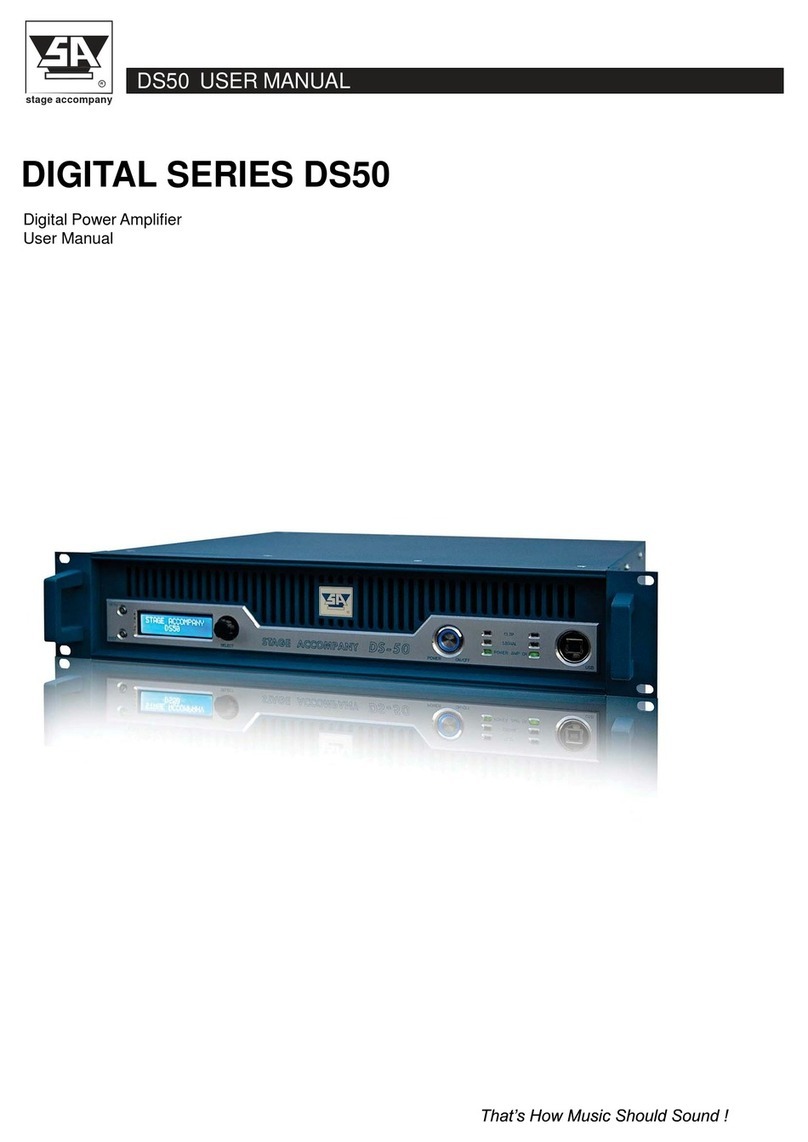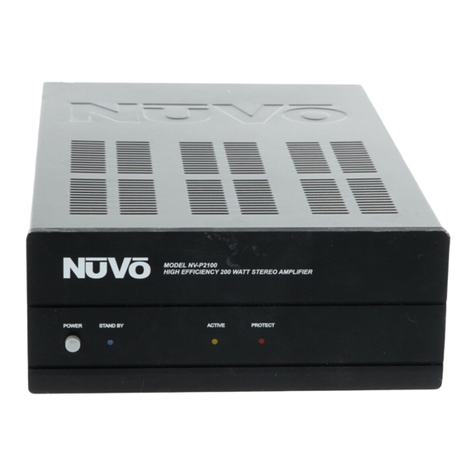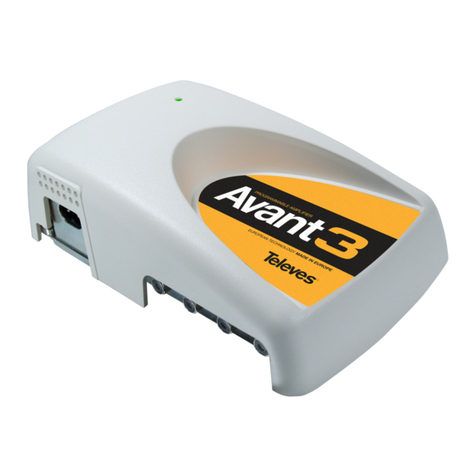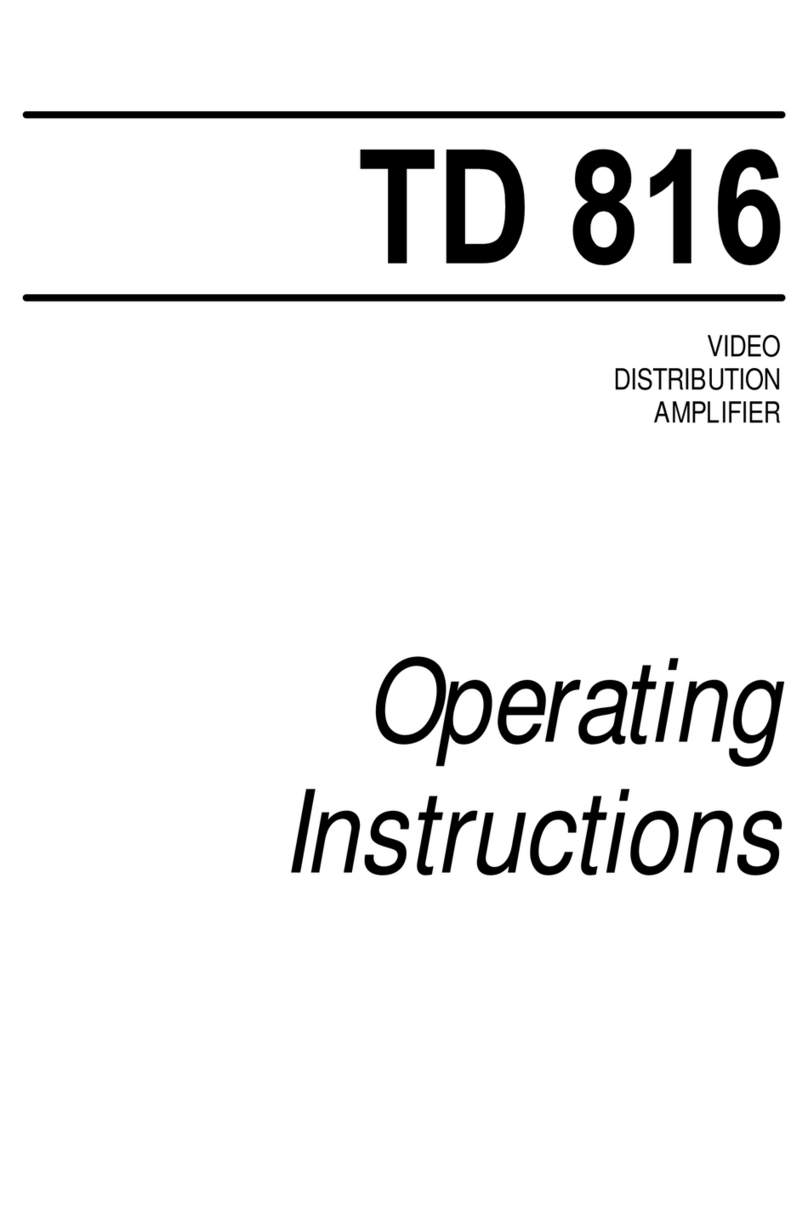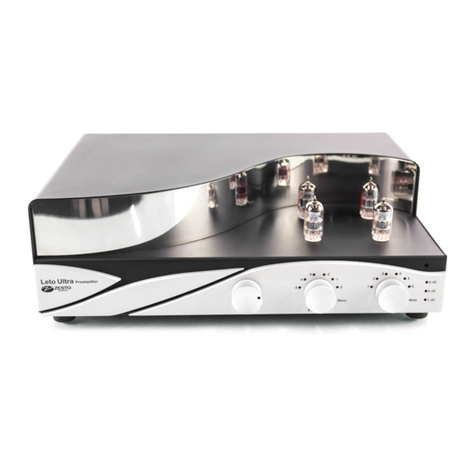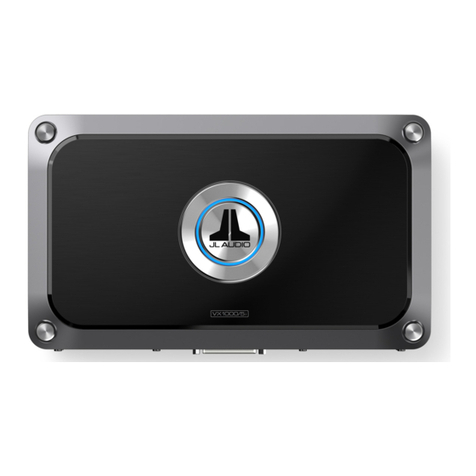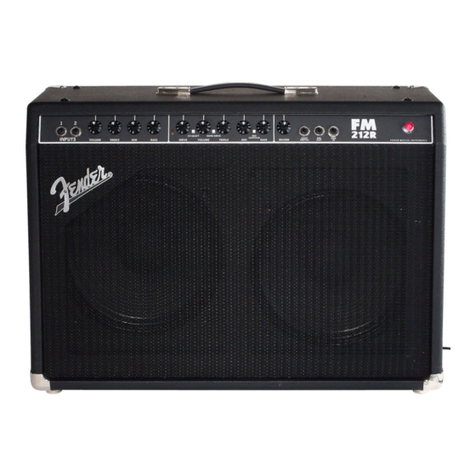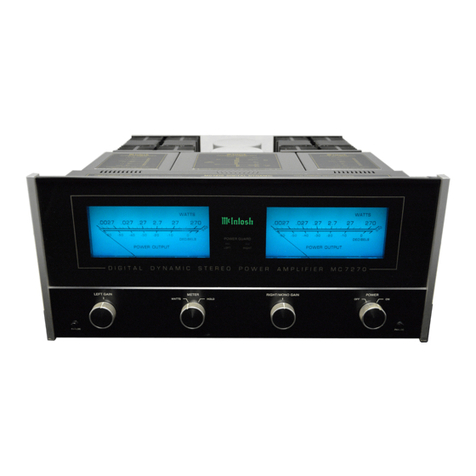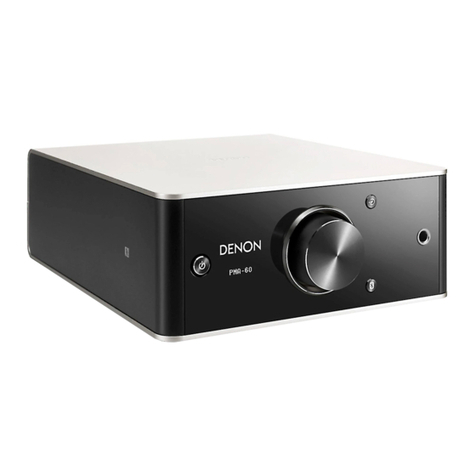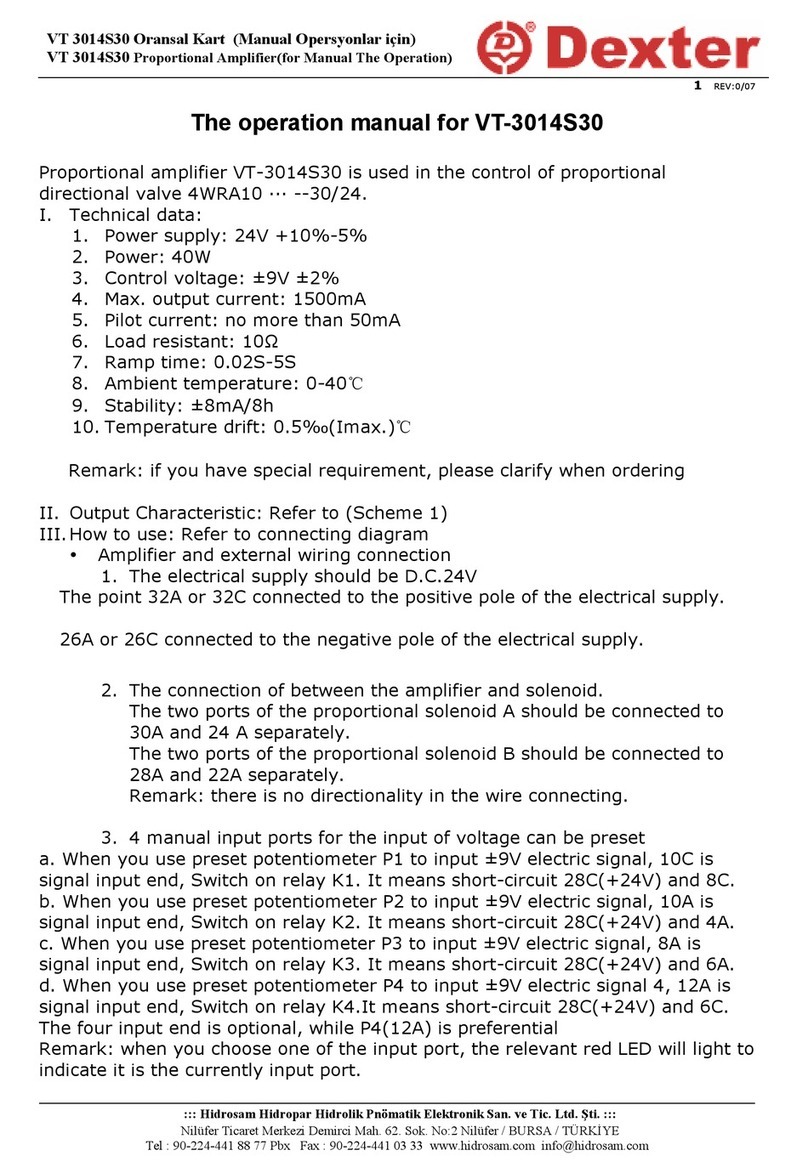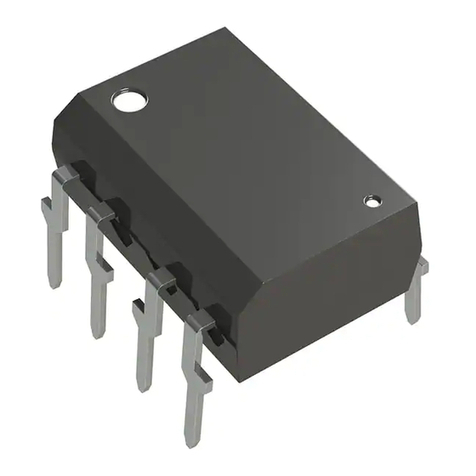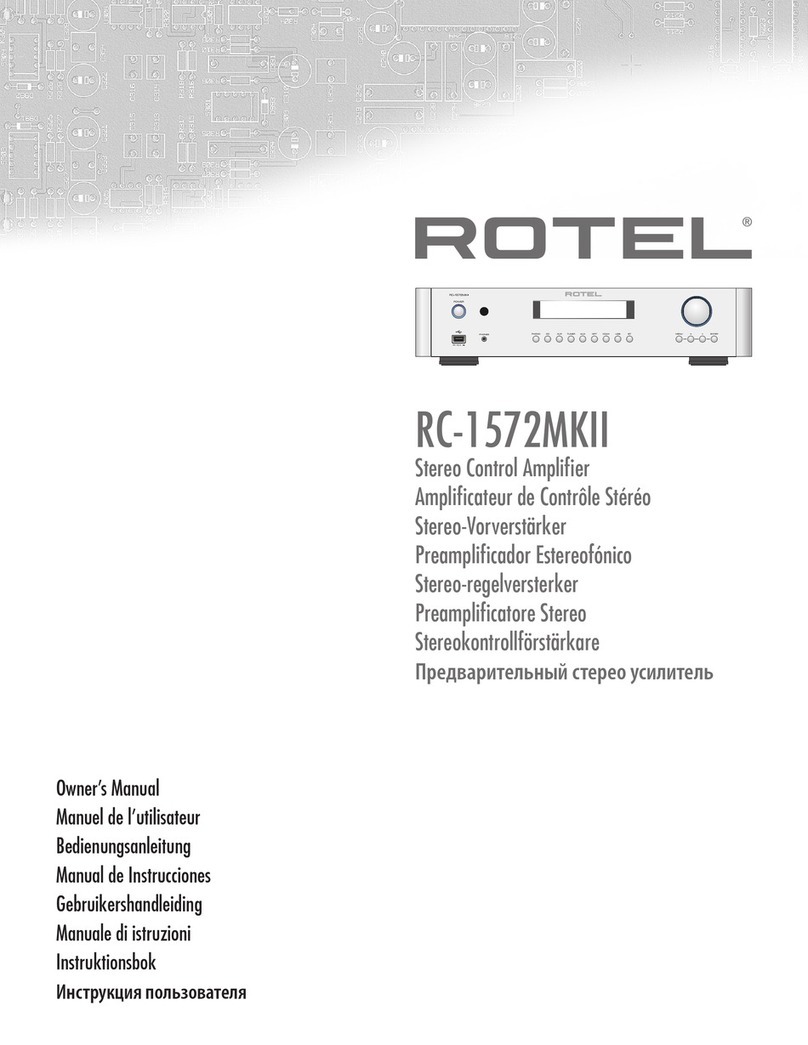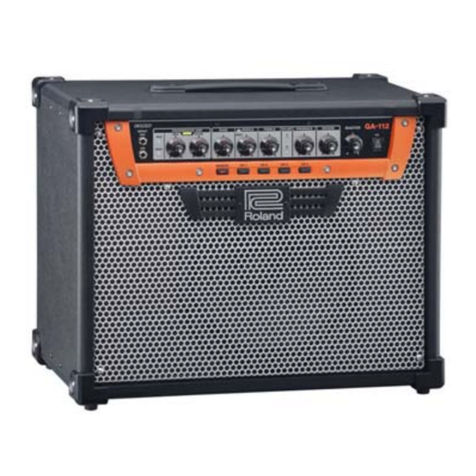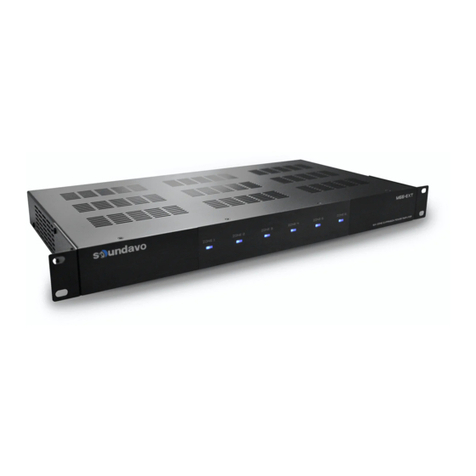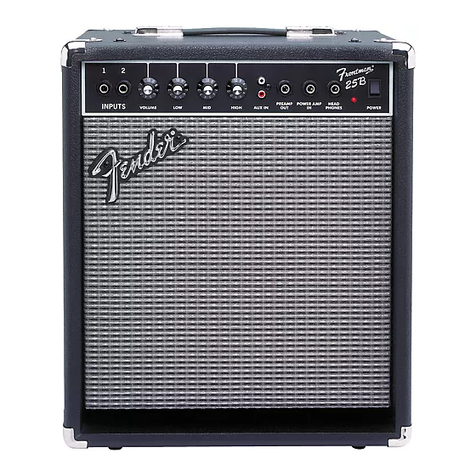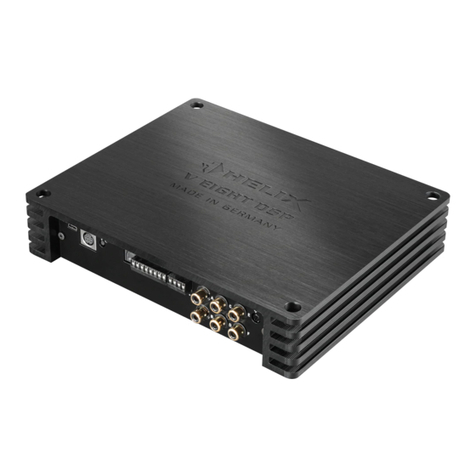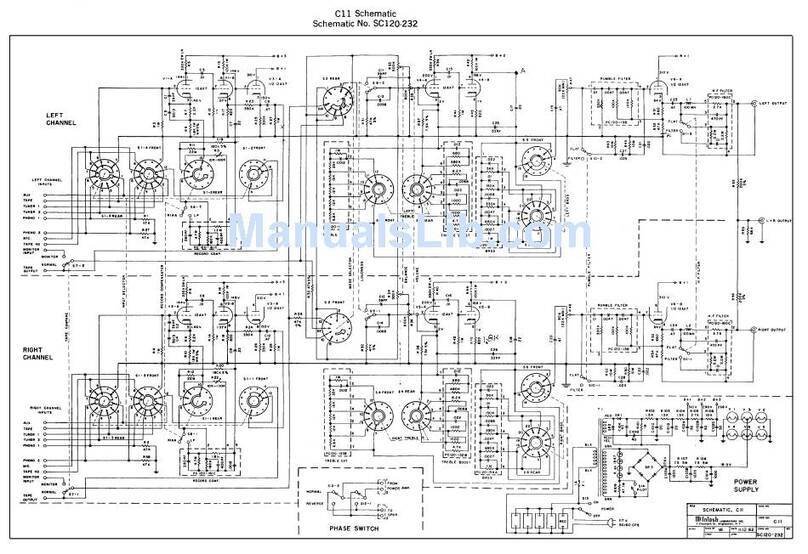Stage Accompany EFFICIENCY SERIES ES 20 User manual

EFFICIENCY SERIES ES 20
High Efficiency Power Amplifier
User Manual
stage accompany
R
ES 20 USER MANUAL

Published by:
New Stage Accompany B.V.
Training & Documentation
Anodeweg 4
1627 LJ Hoorn, The Netherlands
Copyright © 1998 by New Stage Accompany B.V.
All rights reserved. No part of this manual may be reproduced or transmitted in any form or by
any means, electronically or mechanical, without written permission from New Stage Accom-
pany B.V. , except for the inclusion of brief quotations in a review.
First printing, May 1998
Printed in The Netherlands
This manual is intended to provide information about the Stage Accompany ES 20. Every effort
has been made to make this manual complete and as accurate as possible. However no
warranty of suitability, purpose, or fitness is implied. The information is provided on an “as-is”
basis. New Stage Accompany B.V. shall have neither liability nor responsibility to any person
or entity with respect to any loss or damages in connection with or arising from the information
contained in this manual.
New Stage Accompany B.V. reserves the right to alter specifications without prior notice.
stage accompany
R
ES 20 USER MANUAL

stage accompany
R
ES 20 USER MANUAL
Table of Contents
Quick Introduction to the ES 20
Introduction
Connections
Operation
Recommendations
Technical Specifications
Warranty
Overview

Table Of Contents
1 Quick Introduction to the ES 20 ................................. 1-1
2 Introduction ................................................. 2-1
3 Connection of the ES 20 ....................................... 3-1
3.1 Mains Power Connection ................................... 3-1
3.2 Audio Connections ........................................ 3-4
3.3 Loudspeaker Connections .................................. 3-5
4 Operation ................................................... 4-1
4.1 Input Attenuators ......................................... 4-1
4.2 Bridge Mode Switch ....................................... 4-1
4.3 Ground Lift Switch ........................................ 4-2
4.4 Indicators ............................................... 4-2
5 Recommendations for Optimum Use............................. 5-1
6 Technical Specifications....................................... 6-1
7 Warranty .................................................... 7-1
8 Overview.................................................... 8-1
TABLE OF CONTENTS
stage accompany
R
ES 20 USER MANUAL

1 Quick Introduction to the ES 20
Thank you for choosing a Stage Accompany Power Amplifier. Making this choice has guaran-
teed you many years of troublefree amplification.
If you have to start using the ES 20 straight away and do not have time to read the complete
manual, make sure that you at least read the following:
•Ensure that you have a reliable, well earthed power source. The required current for
the ES 20 can be found in the table in paragraph 3.1.
•Connect the ES 20 to your signal sources via the <INPUT> connectors. Connect this
amplifier to other units via the <LINK> outputs using short signal leads. Connect your
single signal source to the channel 1 input if you use the ES 20 in bridge mode.
•Never make connections to the amplifier or to any preceding equipment with the ampli-
fier switched on!
Important
When combining ES 20s with a Stage Accompany Blue Box system,you must take into account
thatthelow-frequency loudspeakeroftheBlueBoxhasanexcursionoppositetothatofanormal
speaker-amplifier combination. The Blue Boxes in combination with the ES 20s have to be
switched to inverted phase, or cross cables for ES 20s or Blue Boxes have to be used!
•Switch the ES 20 on using the <POWER ON/OFF> switch.
If you want to use the ES 20 in bridge mode, set the <MODE> switch at the back of the amplifier
in the <BRIDGE MODE> position. Connect the speaker system to the <BRIDGE MODE
OUTPUT>.
•Select the desired input sensitivity by means of the <INPUT ATTENUATORS>. In
bridge mode, always set the input attenuators in the same position.
•Any earth hum that may be present may be solved with the <GROUND LIFT> switch.
The ES 20 is now ready for use.
QUICK INTRODUCTION
stage accompany
R
ES 20 USER MANUAL
1-1

2 Introduction
The Stage Accompany ES 20 is a dual channel, high efficiency power amplifier and comprises
the following components:
•Balanced input stages.
•Two high efficient amplifiers which deliver each 500 Wrms into 8Ω, 770 Wrms into 4 Ω
and 960 Wrms into 2Ωor 610 W peak into 8 Ω, 1000 W peak into 4 Ω, and 1400 W
peak into 2 Ω
.
•Advanced protection circuits.
The audio inputs and link outputs are connected internally without electronics. This is done to
prevent any loss of sound quality. With an input impedance of 22 kΩ, it is possible to connect
a maximum of 30 ES 20s to a 600 Ωsource like the SA 1310 graphic equaliser. If more than
30 units need to be connected to a single source, a separate signal driver must be used.
The ES 20 is protected against the connection of speaker impedances less than 2 Ωor even
short circuiting of the output. In these cases the output current is limited but the amplifier keeps
working.
The ES 20 has a number of features, including:
•High efficiency class G operation.
•Variable speed DC fan.
•DDC (Dynamic Damping Control).
•EFN circuit (Extended Function Network)
•Soft start to reduce power on inrush current.
•Temperature, DC, HF and short circuit protection.
Class G operation
The power supply of the ES 20 amplifier produces 2 different supply levels. Each channel
actually consists of two power amplifiers. One produces the output signal, the other one selects
the power supply voltage. This way, the ES 20 uses the low level supply at low output power
and the high level supply at high output power which reduces internal dissipation significantly.
INTRODUCTION
stage accompany
R
ES 20 USER MANUAL
2-1

DC Fan
The built in DC fan has a continuous variable speed. Its control circuit monitors the temperature
oftheoutputdevicesandthetemperatureofthepowersupply.Thespeedofthefaniscalculated
out of this information. This system ensures that the fan always runs at optimum speed and
thus produces less noise.
DDC
DDC (Dynamic Damping Control) is a special way of measuring the cone movement of a
loudspeaker. The voltage induced in the voice coil is sensed and fed back to the amplifier’s
feedbackcircuit.Hence,a virtuallyinfinitedampingisachieved,whichresultsinanexceptionally
tight sound reproduction.
EFN
Through the internal EFN circuit, with plug-in modules, extra functions can be added to the
amplifier, like cross-over, high- low- or band-pass filtering, equalisation and loudspeaker
protection. Special protection boards are available for all Stage Accompany loudspeaker
systems. The installation of an EFN module needs to be done by an authorized Stage
Accompany service center.
Soft Start
The soft start circuit is active when the ES 20 is turned on. The mains inrush current, which
normally is in excess of 100 A is limited to a safe value. However, take care not to switch on
too many ES 20 amplifiers at the same time, or you risk that the main fuses of your distribution
may trip.
Temperature, DC, HF and Short Circuit Protection
The amplifier and the loudspeakers are protected against all possible damages.
INTRODUCTION
stage accompany
R
ES 20 USER MANUAL
2-2

3 Connections
Only three connections need to be made: mains power, audio input signals, and loudspeaker
leads. Do not make any connections to the amplifier or to any preceding equipment with the
amplifier switched on!
3.1 Mains Power Connection
The ES 20 is internally selectable for 110-120/220-240V 50/60Hz mains voltage. The exact
voltages are stated at the rear of the amplifier. Switching between mains voltages has to be
done by an authorised Stage Accompany service centre. Connecting to the wrong voltage is
dangerous and may damage the amplifier. Always ensure that you use a correctly grounded
power supply. If more than one ES 20 is to be used, it is advisable to connect each one
separately to the nearest mains supply in stead of connecting several ES 20s using an adapter
block (see figure 3-1).
Mains
Supply
Mains
Supply
ES20
ES20
ES20
ES20
ES20
ES20
OK
Figure 3-1 ES 20 connections to the mains supply.
CONNECTIONS
stage accompany
R
ES 20 USER MANUAL
3-1

This will prevent unnecessary power loss in the mains cables. If circumstances do not allow
this, it is advisable to connect the adapter block directly to the power supply using a short cable
and then connect the individual ES 20s to it using longer leads. Although this method is not
ideal, it does limit power loss as much as possible.
Ultimately, it is possible to place the adapter block near the ES 20s, but if a great deal of power
is required from the unit, the final current provided is far from optimum: loss of current leads to
unrecoverable loss of output power and therefore sound pressure.
Warning :
Always disconnect the ES 20 from the power supply before operating on the fuse holders!
Replace a blown fuse only with a new one of the same type and value!
Current Table
Below, the current consumption of the ES 20 is tabulated for two selectable mains voltages.
The power consumption shown appliesto 1/8 ofmaximumoutput power pinknoisein2 Ω,which
is representative for typical music program with occasional clipping. If your speaker system has
an impedance of 4 or 8 Ωyou may multiply the currents by 0.5 or 0.25.
The mains voltage may NOT deviate more than -20 % to +10 % of the nominal value. The
proportional mains voltage cable loss may not exceed 10 %. The following formula may be used
to calculate the maximum mains cable length in meters for 220-240 V models:
No. ES 20s Mains Voltage (V)
110-120 220-240
Current Consumption (A)
112 6
22412
33618
44824
56030
67236
78442
89648
9 108 54
Table 3-1 Current consumption as a function of the mains voltage at 1/8 of maximum
output power with pink noise in 2 Ω.
CONNECTIONS
stage accompany
R
ES 20 USER MANUAL
3-2

The two input variables are:
N - number of ES 20s supplied through the cable
G - cable gauge in square millimeters
For 110-120 V models the following formula applies:
This means that the cable length is proportional to the cable gauge, while it is inversely
proportional to the number of ES 20s supplied through the cable.
On this and the next page, per mains voltage a table is shown with the maximum mains cable
lengthinmeters,giventhe cablegaugeinsquaremillimetersand thenumberofES20ssupplied
through the cable.
Maximum Length (ML) =
G
*15
N
Maximum Length (ML) =
G
*60
N
110-120 V Cable Gauge (mm2)
1.5 2.5 4.0 6.0 10.0 16.0
No.
of
ES 20s
123386090150240
21119304575120
3 8 13 20 30 50 80
4 6 915233860
5 5 812183048
6 4 610152540
7 3 5 9 13 21 34
8 3 5 8 11 19 30
9 3 4 7 10 17 27
1023691524
Table 3-2 Maximum cable length as a function of the cable gauge and the number of
ES 20s supplied through the cable.
CONNECTIONS
stage accompany
R
ES 20 USER MANUAL
3-3

3.2 Audio Connections
The XLR connectors (audio in and audio link) of the ES 20 are wired as follows:
Pin 1 = ground
Pin 2 = normal phase (signal+ or “hot”)
Pin 3 = inverted phase (signal- or “cold”)
Always use high quality XLR connectors and shielded signal cables. Using the signal link
connectors, up to 30 ES 20s can be linked without a problem. If more than 30 ES 20s need to
be interconnected, a separate signal driver should be used.
Theinputstagesareelectronicallybalanced.Tomakeoptimumuseofthebalancedinputstages
even in unbalanced situations, use balanced signal cables and connect pin 3 to pin 1 at the
output of the preceding equipment. If this is not possible, connect pin 3 to pin 1 at the input of
the ES 20.
NEUTRIK
+
+
12
3
220-240 V Cable Gauge (mm2)
1.5 2.5 4.0 6.0 10.0 16.0
No.
of
ES 20s
1 90 150 240 360 600 960
2 45 75 120 180 300 480
3 30 50 80 120 200 320
423386090150240
518304872120192
615254060100160
71321345186137
81119304575120
91017274067107
10 91524366096
Table 3-3 Maximum cable length as a function of the cable gauge and the number of
ES 20s supplied through the cable.
CONNECTIONS
stage accompany
R
ES 20 USER MANUAL
3-4

3.3 Loudspeaker Connections
Due to theDDC feature, the ES 20 has4 output terminalsper channelinstead of 2.The speakon
connector is wired as follows:
Pin 1+ = “hot” or Signal+
Pin 1- = “cold” or Signal-
Pin 2+ = “DDC hot” or DDC+
Pin 2- = “DDC cold” or DDC-
For optimum performance, the amplifier to loudspeaker connections should be made as shown
in figure 3-2.
The signal+ and DDC+ (Dynamic Damping Control) terminals are linked together at the
loudspeaker +terminal. The signal-and DDC- terminalsare linked atthe loudspeaker -terminal.
A maximum dampingis obtained withthese connections. If your speaker systemis not prepared
for a four terminal connection, link the DDC and the signal leads at the input of the enclosure
(see figure 3-3).
+
+
NEUTRIK
1-
2+
1+
2-
2+
2-
1-
1+
+
-
SPEAKON NL4FC
Figure 3-2 ES 20 4-terminal loudspeaker connection.
2+
2-
1-
1+
+
-
SPEAKON NL4FC
Figure 3-3 ES 20 2-terminal loudspeaker connection
CONNECTIONS
stage accompany
R
ES 20 USER MANUAL
3-5

If you don’t want to use the DDC feature at all, the DDC and the signal leads should be linked
at the amplifier output in the speakon connector (see figure 3-4). The DDC terminals can also
be left unconnected but then the performance will be less.
Warning ! Never short-circuit the DDC terminals, and never connect the signal+ output terminal
to the DDC- terminal or vice versa (see figure 3-5). Since you are disabling the amplifier’s
feedback network, signal gain will be almost infinite. The smallest input signal will result in full
power output with the possibility of square waves damaging your loudspeakers!
Therefore, check your cables regularly. We also advice you to use special Stage Accompany
4-wire loudspeaker cable: 2 x 3.0 mm2and 2 x 0.75 mm2.
2+
2-
1-
1+
+
-
SPEAKON NL4FC
Figure 3-4 ES 20 loudspeaker connection without DDC.
2+
2-
1-
1+
+
-
SPEAKON NL4FC
Figure 3-5 Dangerous ES 20 output connection.
2+
2-
1-
1+
+
-
SPEAKON NL4FC
Figure 3-6 Dangerous ES 20 output connection
CONNECTIONS
stage accompany
R
ES 20 USER MANUAL
3-6

When more speakers are going to be connected to oneamplifier, split the output and DDC leads
as soon as possible behind the output terminals of the ES 20 (see figure 3-7 on this and figure
3-8 on the next page).
2+
2-
1-
1+
+
-
SPEAKON NL4FC
Figure 3-7 Try to avoid this way of connecting several enclosures to the
ES 20.
CONNECTIONS
stage accompany
R
ES 20 USER MANUAL
3-7

The amplifier can cope with any load of 2 Ωor higher. This means that you may connect a
maximum of two 4 Ω, four 8 Ω, or eight 16 Ωloudspeakers per channel in parallel. Linking the
loudspeakers from one enclosure to another has two major disadvantages:
1.The loudspeaker cable from the amplifier to the first enclosure conducts the current for all
enclosures, which means extra losses.
2.The DDC only works for the first enclosure.
Splitting the leads at the amplifier output terminals solves these problems (see figure 3-8). The
DDC system corrects the performance loss due to connectors, loudspeaker cables and so on.
However, it cannot prevent loss of power. So only use cables of minimal 2 x 1.5 mm2or more
for the loudspeaker leads and 2 x 0.75 mm2for the DDC leads.
For bridge mode operation, connect the speaker to the bridge mode output connector. Its wiring
is identical to the other outputs.
2+
2-
1-
1+
+
-
SPEAKON NL4FC
OK
Figure 3-8 Correct way of connecting several enclosures to the ES 20
2+
2-
1-
1+
+
-
SPEAKON NL4FC
Figure 3-9 ES 20 bridge mode to loudspeaker connections.
CONNECTIONS
stage accompany
R
ES 20 USER MANUAL
3-8

An indication of the proportional cable power loss (percentage of the amplifier’s total output
power) can be calculated using the following formula:
where the variables represent:
L - cable length in meters
G - cable gauge in square millimeters
R - DC resistance of the loudspeaker(s) in ohms
This formula is based on the DC resistance in stead of the complex impedance of the
loudspeaker(s). However, the approximation can be used to get a good impression of the
loudspeaker cable power loss. Per loudspeaker impedance a table is shown in tables 3-9 to
3-12 with the proportional power loss, given the loudspeaker cable gauge in square millimeters
and the cable length in meters.
Proportional Power Loss = 100
29.4 * G * R
L
1+
16 ΩCable Gauge (mm2)
1.5 2.5 3.0 4.0 6.0 10.0 16.0
Cable
Length
(m)
10 1.4 0.8 0.7 0.5 0.4 0.2 0.1
20 2.8 1.7 1.4 1.1 0.7 0.4 0.3
30 4.1 2.5 2.1 1.6 1.1 0.6 0.4
40 5.4 3.3 2.8 2.1 1.4 0.8 0.5
50 6.6 4.1 3.4 2.6 1.7 1.1 0.7
100 12.4 7.8 6.6 5.0 3.4 2.1 1.3
Table 3-4 Proportional power loss as a function of loudspeaker cable gauge and cable
length (%).
CONNECTIONS
stage accompany
R
ES 20 USER MANUAL
3-9

8ΩCable Gauge (mm2)
1.5 2.5 3.0 4.0 6.0 10.0 16.0
Cable
Length
(m)
10 2.8 1.7 1.4 1.1 0.7 0.4 0.3
20 5.4 3.3 2.8 2.1 1.4 0.8 0.5
30 7.8 4.9 4.1 3.1 2.1 1.3 0.8
40 10.2 6.4 5.4 4.1 2.8 1.7 1.1
50 12.4 7.8 6.6 5.0 3.4 2.1 1.3
100 22.1 14.5 12.4 9.6 6.6 4.1 2.6
Table 3-5 Proportional power loss as a function of loudspeaker cable gauge and cable
length (%).
4ΩCable Gauge (mm2)
1.5 2.5 3.0 4.0 6.0 10.0 16.0
Cable
Length
(m)
10 5.4 3.3 2.8 2.1 1.4 0.8 0.5
20 10.2 6.4 5.4 4.1 2.8 1.7 1.1
30 14.5 9.3 7.8 6.0 4.1 2.5 1.6
40 18.5 12.0 10.2 7.8 5.4 3.3 2.1
50 22.1 14.5 12.4 9.6 6.6 4.1 2.6
100 36.2 25.4 22.1 17.5 12.4 7.8 5.0
Table 3-6 Proportional power loss as a function of loudspeaker cable gauge and cable
length (%).
2ΩCable Gauge (mm2)
1.5 2.5 3.0 4.0 6.0 10.0 16.0
Cable
Length
(m)
10 10.2 6.4 5.4 4.1 2.8 1.7 1.1
20 18.5 12.0 10.2 7.8 5.4 3.3 2.1
30 25.4 16.4 14.5 11.3 7.8 4.9 3.1
40 31.2 21.4 18.5 14.5 10.2 6.4 4.1
50 36.2 25.4 22.1 17.5 12.4 7.8 5.0
100 53.1 40.5 36.2 29.8 22.1 14.5 9.6
Table 3-7 Proportional power loss as a function of loudspeaker cable gauge and cable
length (%).
CONNECTIONS
stage accompany
R
ES 20 USER MANUAL
3-10

4 Operation
After connection to the correct mainsvoltage, the ES 20 can be switched on usingthe <POWER
ON/OFF> switch.
The various functions of the system will now be described one after one.
4.1 Input Attenuators
The input attenuators consist of two 21-detent conductive plastic potentiometers. 11 of the
detents are calibrated in dB. The attenuators are used to mute the input signal or to adjust the
sensitivity of the ES 20 to other amplifiers. The sensitivity in the 0 dB position is +6 dBu for 49
V output (600 W into 4 Ω). The relative sensitivity to other Stage Accompany amplifiers is:
ES 10: +3 dB
ES 40: -3 dB
SA 800: +3 dB
SA 1600 0 dB
PPA 1200: 0 dB
Attenuation in the complete counter clockwise position (-∞) is > 90 dB.
Warning:
For bridge mode operation, always set the input attenuators in the same position. If the
attenuators are not in the same position, either:
•the amplifier can not deliver its maximum power
•the most attenuated channel can run hot
•at maximum power, the most attenuated channel will limit its output current first, result-
ing in distortion
4.2 Bridge Mode Switch
The <BRIDGE MODE> switch toggles the amplifier between stereo and bridge mode. In stereo
mode, the channel 1 input feeds the channel 1 amplifier, and the channel 2 input feeds the
channel 2 amplifier. In bridge mode, the channel 1 input connector feeds both amplifiers. The
channel 2 input is not used and is decoupled from the amplifier.
To prevent difficult output connections, the ES 20 is equipped with a unique separate bridge
OPERATION
stage accompany
R
ES 20 USER MANUAL
4-1

mode output.
4.3 Ground Lift Switch
Ifhumis audibleafter switching onthe ES20, the causemay beincorrect earthingof yoursound
system. The <GROUND LIFT> switch can be used to “lift” the connection between the system
earth and the mains earth. This action alone is often sufficient to eliminate the undesired noise
caused by a “bad grounding system”, or “ground loops”.
4.4 Indicators
Each channel of the amplifier is equipped with the following indicators:
•Power: these LEDs will light when the amplifier is switched on.
•Signal present: these LEDs will light when an input level of more than 40 dB under the
level that would cause maximum power (+6 dBu) is detected. The signal present LEDs
work independently of the settings of the input attenuators.
•Thermal: when the output devices of a channel have reached a temperature of 90 °C,
the input of that channel is muted and the thermal LED will light. Both channels work
independently, so thermal overload of one channel does not affect the other channel.
In case of a continued overload of both channels, it is possible that the power supply
runs hot. In that case, both inputs are muted simultaneously.
•DC: the DC LEDs indicate that the output of the amplifier is decoupled from the output
connectors. This occurs when the amplifier is switched on and the electronic circuits
need time to stabilise. This takes approximately one second. Besides, during normal
operation, the amplifier output is decoupled from the output connectors if a dangerous
DC voltage is present at the amplifier output.
When the DC LEDs light during normal use, check the following things: Disconnect the
speaker system. When the LED(s) switch(es) off, the DDC is probably not properly
connected.
When this does not solve the problem, the amplifier is damaged and should be re-
paired by an authorised Stage Accompany service centre.
•Clip: this LED will light when the output level of the amplifier has reached its limit. The
indication is correct for every connected impedance. When the clip LEDs flash fre-
quently, distortion is to be expected.
OPERATION
stage accompany
R
ES 20 USER MANUAL
4-2

5 Recommendations for Optimum Use
•Ensure that the quality of the mains supply is good enough and that it can supply the
required peak currents. In addition, good earthing is necessary to prevent noise, hum
and safety problems. If hum does occur, it can almost always be solved by using the
ground lift switch on the back of the amplifier.
•Be sure that the ES 20 is built into a space with sufficient circulation of fresh air. A tem-
perature that is constantly too high leads to switching on and off of the thermal protec-
tion and considerably reducing the lifetime of the amplifier.
•When built into a flightcase, ensure yourself that there are sufficient possibilities for the
heated air to leave the flightcase. When more ES 20s are built into one flightcase, in-
stall an extra fan in the case. Air flow of the ES 20 goes from front to back.
•Do not make connections to the amplifier or to any preceding equipment with the am-
plifier switched on
•A faulty fuse must ALWAYS be replaced by a new one of the same type and value! A
different fuse can cause permanent damage to the amplifier. All internal fuses are of
an automatic type, so they do not need to be replaced. Always disconnect the ES 20
from the power supply before operating on the fuse holder! When a replaced fuse im-
mediately blows again, the amplifier is defect and should be repaired by an authorised
Stage Accompany service centre. Do not try to replace the fuse again because you
may risk further damage to the amplifier.
•Repairs to the ES 20 should only be carried out by an authorised Stage Accompany
service centre. Never dismantle the ES 20 yourself, you may risk damaging vital com-
ponents: moreover, the guarantee becomes irrevocably invalidated.
•Read this manual carefully. Try out the various functions described in this manual. In
this way you will soon become familiar with the many possibilities that the ES 20 of-
fers. It is just as important that your colleagues who will use the ES 20 also read the
manual! With a good knowledge of the working of the ES 20, it is possible to fully util-
ize its superior sound quality in every situation.
GOOD LUCK!
RECOMMENDATIONS
stage accompany
R
ES 20 USER MANUAL
5-1
Table of contents
Other Stage Accompany Amplifier manuals


